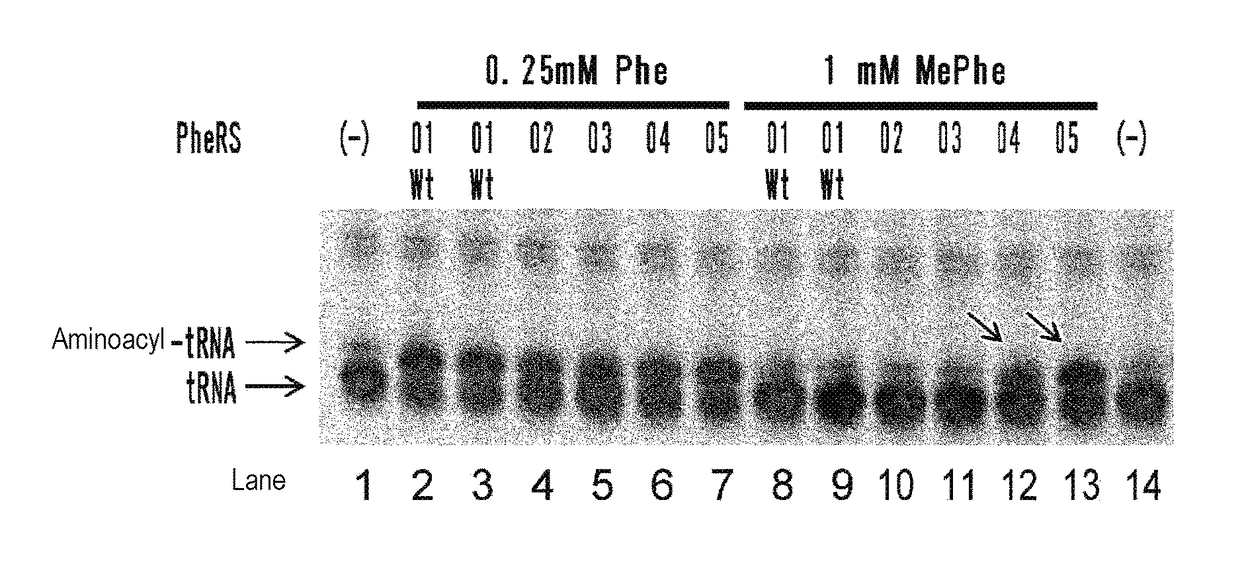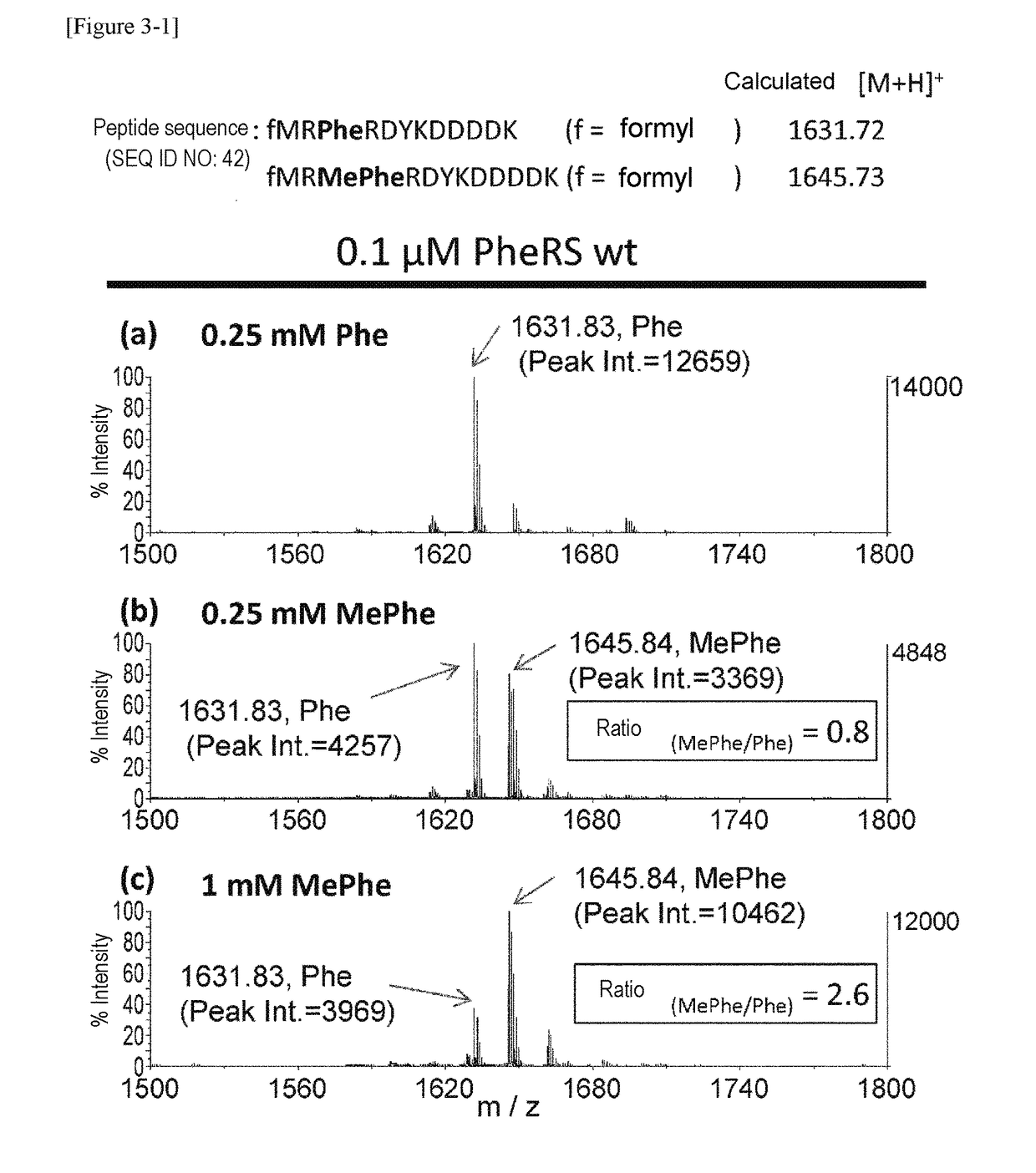MODIFIED AMINOACYL-tRNA SYNTHETASE AND USE THEREOF
a technology of aminoacyltrna and synthetase, which is applied in the field of aminoacyltrna synthetase, can solve the problems of contamination of trace amounts of natural amino acids, limited side chains that are efficiently translated in this method, and cumbersome operations, and achieves high translation efficiency, high translation efficiency, and high translation efficiency.
- Summary
- Abstract
- Description
- Claims
- Application Information
AI Technical Summary
Benefits of technology
Problems solved by technology
Method used
Image
Examples
example 1
henylalanine-Accepting ARS
[0214]Using a plasmid (pQE-32(2) 2_wtPheRS) comprising the ORF sequence of wild-type PheRS α subunit gene of E. coli (SEQ ID NOs: 27, 28) as starting material, mutant PheRS plasmids (having His-tag (6×His) at the N-terminus) listed in Table 1 were constructed by introducing site-directed mutations using PCR. Specifically, 2 μL of 10 ng / μL template, 10 μL of 2×KOD Fx buffer (TOYOBO, KFX-101), 0.6 μL of 10 μM forward primer, 0.6 μL of 10 μM reverse primer, 4 μL of 2 mM dNTP, 0.4 μL of KOD FX (TOYOBO, KFX-101), and 2.4 μL of H2O were mixed together. Thereafter, the resulting reaction solution was heated at 94° C. for 2 minutes and then subjected to 10 cycles, each consisting of heating at 98° C. for 10 seconds and heating at 68° C. for 7 minutes, to amplify the mutant gene. The combinations of the template plasmid, forward primer, and reverse primer used are listed in Table 2. Each sequence of primers “F.F02” through “F.F05” corresponds to SEQ ID NOs: 30-33 in...
example 2
aline-Accepting ARS
[0231]The mutant ValRS plasmids (having His-tag (6×His) at the N-terminus) listed in Table 3 were constructed by introducing site-directed mutations using PCR into the plasmid (PQE-32(2) 2_wtVALRS) comprising the ORF sequence of wild-type ValRS gene of E. coli (SEQ ID NOs: 23, 24), which was used as starting material. Specifically, 2 μL of 10 ng / μL template, 10 μL of 2×KOD Fx buffer (TOYOBO, KFX-101), 0.6 μL of 10 μM forward primer, 0.6 μL of 10 μM reverse primer, 4 μL of 2 mM dNTP, 0.4 μL of KOD FX (TOYOBO, KFX-101), and 2.4 μL of H2O were mixed together. Then, the resulting reaction solution was heated at 94° C. for 2 minutes and then subjected to 10 cycles, each consisting of heating at 98° C. for 10 seconds and heating at 68° C. for 7 minutes, to amplify the mutant gene. The combinations of the template plasmid, forward primer, and reverse primer used are listed in Table 4. Each sequence of primers “F.V2” through “F.V19”, “F.V46” through “F.V48”, and “F.V13-01...
example 3
nt of N-Methylserine-Accepting ARS
[0250]The mutant SerRS plasmids (having His-tag (6×His) at the N-terminus) listed in Table 5 were constructed by introducing site-directed mutations using PCR into a plasmid comprising the ORF sequence (SEQ ID NOs: 25, 26) of wild-type SerRS gene of E. coli (PQE-32(2) 2_wtSERRS), which was used as starting material. Specifically, 2.5 μL of 10 ng / μL template, 12.5 μL of 2×KOD Fx buffer (TOYOBO, KFX-101), 0.75 μL of 10 μM forward primer, 0.75 μL of 10 μM reverse primer, 5 μL of 2 mM dNTP, 0.5 μL of KOD FX (TOYOBO, KFX-101), and 3 μL of H2O were mixed together. Next, the resulting reaction solution was heated at 94° C. for 2 minutes and then subjected to 10 cycles, each consisting of heating at 98° C. for 10 seconds and heating at 68° C. for 7 minutes, to amplify the mutant gene. The combinations of the template plasmid, forward primer, and reverse primer used are listed in Table 6. Each sequence of primers “F.S2” through “F.S8”, “F.S15” through “F.S23...
PUM
| Property | Measurement | Unit |
|---|---|---|
| pH | aaaaa | aaaaa |
| pH | aaaaa | aaaaa |
| OD | aaaaa | aaaaa |
Abstract
Description
Claims
Application Information
 Login to View More
Login to View More - R&D
- Intellectual Property
- Life Sciences
- Materials
- Tech Scout
- Unparalleled Data Quality
- Higher Quality Content
- 60% Fewer Hallucinations
Browse by: Latest US Patents, China's latest patents, Technical Efficacy Thesaurus, Application Domain, Technology Topic, Popular Technical Reports.
© 2025 PatSnap. All rights reserved.Legal|Privacy policy|Modern Slavery Act Transparency Statement|Sitemap|About US| Contact US: help@patsnap.com



